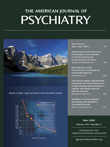Randomized, Double-Blind Trial of Olanzapine Versus Placebo in Patients Prodromally Symptomatic for Psychosis
Abstract
Objective: This study assessed the efficacy of olanzapine in delaying or preventing conversion to psychosis and reducing symptoms in people with prodromal symptoms of schizophrenia. Method: This randomized trial occurred at four North American clinics in the Prevention Through Risk Identification, Management, and Education project. Outpatients received olanzapine (5–15 mg/day, N=31) or placebo (N=29) during a 1-year double-blind treatment period and no treatment during a 1-year follow-up period. Efficacy measures included the conversion-to-psychosis rate and Scale of Prodromal Symptoms scores. Results: During the treatment year, 16.1% of olanzapine patients and 37.9% of placebo patients experienced a conversion to psychosis, a nearly significant difference. The hazard of conversion among placebo patients was about 2.5 times that among olanzapine-treated patients, which also approached significance. In the follow-up year, the conversion rate did not differ significantly between groups. During treatment, the mean score for prodromal positive symptoms improved more in the olanzapine group than in the placebo group, and the mixed-model repeated-measures least-squares mean score showed significantly greater improvement between weeks 8 and 28 with olanzapine. The olanzapine patients gained significantly more weight (mean=8.79 kg, SD=9.05, versus mean=0.30 kg, SD=4.24). Conclusions: A significant treatment difference in the conversion-to-psychosis rate was not demonstrated. However, these results may be influenced by low power. The nearly significant differences suggest that olanzapine might reduce the conversion rate and delay onset of psychosis. Olanzapine was efficacious for positive prodromal symptoms but induced weight gain. Further treatment research in this phase of illness is warranted.



